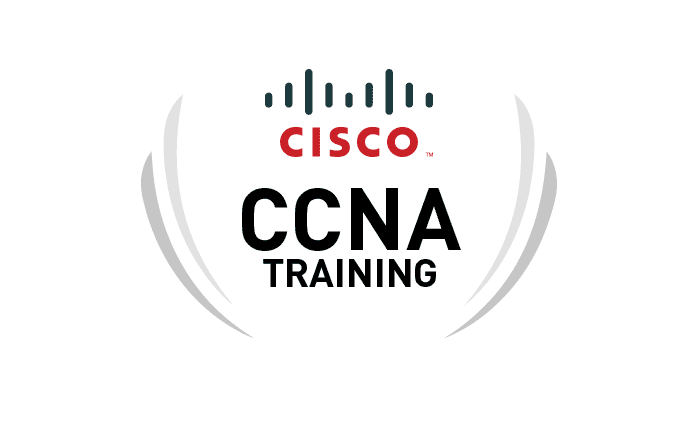
CCNA گام اول برای ورود به دنیای شبکه های مبتنی بر تجهیزات سیسکو است و سرنام Cisco® Certified Network Associate می باشد.
دوره پیاده سازی و مدیریت راهکارهای سیسکو CCNA v1.0 ، طیف گسترده ای از دانش پایه ای شبکه برای کلیه مشاغل حوزه های IT را در قالب آموزش ترکیبی مدرس محور ، لابراتوارهای آموزشی و شیوه خودآموز(self-study) برای علاقه مندان ارائه می نماید. متقاضیان دوره، نحوه نصب ، اجرا ، پیکربندی، تأیید شبکه های IPv4 و IPv6 ، پیکربندی دیوایس های شبکه مانند سوئیچ ها ، روترها ، Access Point ها و کنترلر شبکه های wireless LAN، مدیریت تجهیزات شبکه و شناسایی تهدیدات مهم امنیتی به همراه آشنایی مقدماتی برنامه نویسی تحت شبکه ، اتوماسیون و شبکه های مبتنی بر نرم افزار(software-defined networking) را فرا می گیرند.
این دوره، آمادگی لازم جهت شرکت در آزمون جدید ۳۰۱-۲۰۰ Cisco® Certified Network Associate (CCNA) برای کسب مدرک CCNA که از تاریخ ۲۴ فوریه سال ۲۰۲۰ در دسترس می باشد، محسوب می شود.
شرکت سیسکو پیش نیازهایی از قبیل آشنایی با مباحث IP ، سیستم عامل و اینترنت و آشنایی با مباحث شبکه را برای این دوره الزامی دانسته و دوره مشخصی را بعنوان پیشنیاز الزامی و رسمی در نظر نگرفته است . اما بنا بر تجربه و بازخوردهایی که از دانشجویان نت ویژن طی دوره های متعدد گرفته شده ،دریافتیم که دانشجویانی که دوره +Network را گذرانده اند درک بهتری از مباحث ارائه شده در دوره CCNA دارند.لذا توصیه میشود حتما افراد با مباحث کلیدی دوره Network Plus (Network+) آشنایی داشته باشند و ترجیحا این دوره را بعنوان پیش نیاز گذرانده باشند تا بتوانند از دوره CCNA بهره لازم را ببرند.
Outline
Implementing VLANs and Trunks
Routing Between VLANs
Introducing OSPF
Building Redundant Switched Topologies
Improving Redundant Switched Topologies with EtherChannel
Exploring Layer 3 Redundancy
Introducing WAN Technologies
Explaining Basics of ACL
Enabling Internet Connectivity
Introducing QoS
Explaining Wireless Fundamentals
Introducing Architectures and Virtualization
Explaining the Evolution of Intelligent Networks
Introducing System Monitoring
Managing Cisco Devices
Examining the Security Threat Landscape
Implementing Threat Defense Technologies
Securing Administrative Access
Implementing Device Hardening
Lab outline
Get Started with Cisco Command-Line Interface (CLI)
Observe How a Switch Operates
Perform Basic Switch Configuration
Implement the Initial Switch Configuration
Inspect TCP/IP Applications
Configure an Interface on a Cisco Router
Configure and Verify Layer 2 Discovery Protocols
Implement an Initial Router Configuration
Configure Default Gateway
Explore Packet Forwarding
Troubleshoot Switch Media and Port Issues
Troubleshoot Port Duplex Issues
Configure Basic IPv6 Connectivity
Configure and Verify IPv4 Static Routes
Configure IPv6 Static Routes
Implement IPv4 Static Routing
Implement IPv6 Static Routing
Configure VLAN and Trunk
Troubleshoot VLANs and Trunk
Configure a Router on a Stick
Implement Multiple VLANs and Basic Routing Between the VLANs
Configure and Verify Single-Area OSPF
Configure and Verify EtherChannel
Improve Redundant Switched Topologies with EtherChannel
Configure and Verify IPv4 ACLs
Implement Numbered and Named IPv4 ACLs
Configure a Provider-Assigned IPv4 Address
Configure Static NAT
Configure Dynamic NAT and Port Address Translation (PAT)
Implement PAT
Log into the WLC
Monitor the WLC
Configure a Dynamic (VLAN) Interface
Configure a DHCP Scope
Configure a WLAN
Define a Remote Access Dial-In User Service (RADIUS) Server
Explore Management Options
Explore the Cisco DNA™ Center
Configure and Verify NTP
Configure System Message Logging
Create the Cisco IOS Image Backup
Upgrade Cisco IOS Image
Configure WLAN Using Wi-Fi Protected Access 2 (WPA2) Pre-Shared Key (PSK) Using the GUI
Secure Console and Remote Access
Enable and Limit Remote Access Connectivity
Secure Device Administrative Access
Configure and Verify Port Security
Implement Device Hardening
قوانین ثبت دیدگاه